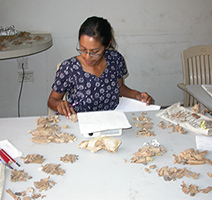
Nancy F. asks “If most food is perishable, how can you tell what kind of food people ate when they lived at a particular archaeological site?”
Beyond needing to eat to survive, what people eat and how we prepare and consume food play important roles in defining and creating social identities and membership in particular cultural traditions. Archaeologists use a variety of techniques to study ancient diets and subsistence practices.
Archaeozoologists (or zooarchaeologists) study animal bones or "faunal remains", which are the most durable ancient food remains. Through comparisons with known specimens, archaeozoologists can identify the species, age, sex and part of the animal and whether it was wild or domestic. Cut marks and charring inform on cooking techniques. The spatial distribution of faunal remains across and between sites can tell us about differential access to kinds and cuts of animal foods.
In many archaeological contexts, plant remains don't preserve. However, burnt or “carbonized” remains do. While carbonized nutshells and wood charcoal often can be recovered in screens, another technique is needed to recover very small seeds and plant parts. In flotation, soil samples from archaeological sites are dumped into buckets of water and stirred Because carbonized plant materials are less dense than water they float to the top where they can be collected and studied by archaeobotanists or paleoethnobotanists. Researchers identify the species, part of plant, seasonality, processing techniques, whether wild or domestic, etc.
In recent decades, new techniques from the biological and chemical sciences have greatly expanded the archaeological toolkit. DNA analysis, and analyses of staple isotopes, lipids, and microscopic starch grains and pollen have greatly expanded our ability to examine ancient environment and subsistence.